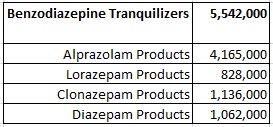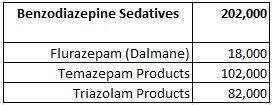ARTICLE OVERVIEW: Benzodiazepines act on the brain by slowing down its activity. These medications are some of the most abused prescription drugs in U.S. Check out the recent statistics on how many people abuse benzos and what the possible treatment options are here.
ESTIMATED READING TIME: 7 minutes
TABLE OF CONTENTS:
- Basics
- Effects and Abuse
- Mixing Benzos
- Abuse Statistics
- How Does Addiction Develop?
- Treating Addiction
- How to Beat Addiction
Benzodiazepines can be dangerous.
Understanding Benzodiazepines
Benzodiazepines, commonly known as benzos, are pharmaceutical medications that are used for many mental issues such as panic attacks, seizures, or anxiety. Sometimes, they are used to manage alcohol withdrawal symptoms. Below is a list of the generic names of benzos, and well as their brand names:
- Alprazolam – Xanax
- Clonazepam – Klonopin
- Diazepam – Valium
- Lorazepam – Ativan
- Temazepam – Restoril
These medications are classified as Schedule IV by the Controlled Substances Act [1] which means that they have a low potential for abuse and low risk of dependence.But, benzos can be really addictive, and dangerous medications. In fact, a NIDA study has found that these medications cause addiction in a similar way as opioids, cannabinoids, and GHB. [2]
Many researchers have come to understand that benzodiazepines have their own addictive potential. But there is still no strong movement to classify them as dangerous, even though they are.
Finally, it is important to know that benzodiazepines are part of a drug classification type known as “depressants” because they work to slow down the brain. Theyare divided into two main groups: tranquilizers and sedatives. Moreover, benzodiazepines can be divided according to the length of time they are active in the body, which is measured by the half-life of each medication:
1. Short-acting benzodiazepines. These benzos have a short half-life, which means they are processed more quickly, and leave the body faster.
2. Long-acting benzodiazepines. These medicines have a long half-life, which means they stay in the body longer because are processed more slowly.
Benzos can have a serious effect on your health.
Benzodiazepines Effects and Abuse
Benzodiazepines act directly on the central nervous system by binding with GABA receptors. This leads to slowing down brain function and relieving metal stress. In addition, benzos may produce euphoria, especially if used for a long period of time.And when you get high on benzos over the long run, benzos can put your health in serious risk.
But, when does use become abuse?
Any use of benzodiazepines without a doctor’s recommendation is considered abuse. Also, if you take benzos in a way as not recommended by your doctor, this is considered abuse. If you crush, inject, chew, or snort benzos, you are abusing the drug. Some of the negative physical and mental side effects caused by benzo abuse include:
- Anxiety
- Blurred vision
- Blunted emotions
- Confusion
- Dizziness
- Depression
- Drowsiness
- Headaches
- Lack of motor coordination
- Loss of self-confidence
- Memory lapses
- Physical weakness
- Poor judgment
- Problems breathing
- Sleep disturbances
- Slurred speech
- Tremors
Additionally, abusing benzodiazepines can affect your personal life, not just your health. Some of the negative consequences may include:
- Financial problems
- Losing close friends
- Problems with family
- Troubles performing in work/school duties
Benzos can be addictive.
Benzodiazepines and Other Drugs
People who work with addiction report that benzodiazepines are rarely abused by their own, and they are not typically the first drug of choice. Usually, these medications are often used in combination with other substances.The most recent SAMHSA DAWN report shows that during 7 years, almost a million emergency department visits occurred due to combination of benzodiazepines with opioid painkillers, alcohol, or other substances. [3]
Alcohol, painkillers, and other benzos are the most common substances used in combination with benzodiazepines.
Why do people combine benzos with other substances? Some of the reasons people mix benzos with other drugs are to boost the effect of the two drugs together. Others believe that mixing prescription pills is a safer practice than mixing illicit drugs with alcohol or other substances. However, there are way too many risks and dangers connected with mixing benzodiazepines and other substances.The main dangers include:
1. Drug synergism.
When you use medications with similar effects, the final outcome you can get is drug synergism. Both substances can produce high, enhanced, significantly increased effects. Meaning that 2+2 won’t be 4, it may be 8 or 10, or even higher.
2. Increased risk of overdose.
Mixing any two substances increase the chances for fatal overdose. It’s hard to overcome an overdose on one substance, but imagine what could happen if you OD on two. Smaller amounts of two different substances are needed to cause suppressed breathing, and/or organ failure that can result in death.
3. Slow physical reactions.
Because of synergistic effects of both drugs, you may experience slow motor reaction, lack of coordination, and impairment.
4. Decreased cognition.
You may experience decreased cognitive ability because of the enhanced effects of the both substances. This can lead to impaired judgment that can put you in risky situations and bad decisions.
5. Increased potential for acute conditions.
Mixing benzodiazepines with other substances increases the potential for heart attack, stroke, seizures, psychosis, or suicidal tendencies.
6. Increased the risk for addiction.
Long-term abuse of mixing benzos with other substances increase the risk of drug dependence and addiction. Withdrawal from two substances can lead to fatal outcomes, and treatment is a must.
7. Increased risk of mental health disorder.
Prolonged polydrug use increases the probability to develop some mental health disorder such as depression, anxiety, or stress disorders.
Call us to discuss benzodiazepine addiction.
Benzodiazepine Abuse Statistics
There is a benzo problem in the U.S. So, if you’re facing an addiction, you are not alone. Take a look at these numbers and then give us a call to talk about getting out of the cycle. You don’t need to live with the need for benzodiazepines every day.
According to the 2017 National Survey of Drug Use and Health, about 5.5 million people aged 12 or older were current abusers of benzodiazepine tranquilizers,and 202,000 people aged 12 or older were current abusers of benzodiazepine sedatives.[4] This break downs by types of benzodiazepine as follows.


Moreover, the Surgeon General’s Report in 2015 stated that 18.9 million individuals misused benzodiazepines [5]:
- 6.1 million people misused tranquilizers such as Xanax.
- 1.5 million people misused sedatives such as Valium.
Additionally, the 2014 DAWN Report of 2014 found that people came to hospitals for overdoses in the hundreds of thousands. From 2005 to 2011,over 943K emergency department visits involved benzodiazepine overdose alone or in combination with opioid pain relievers, or alcohol, or other substances. The benzodiazepine-only visits happened among all ages:
- 174,998 aged 12 to 34
- 88,644 aged 35 to 44
- 150,780 aged 45 to 64
- 72,575 aged 65 and older
Finally, the CDC Report on Drugs Most Frequently Involved in Drug Overdose Deaths showed that about 6,000 overdose deaths involved benzodiazepines in 2014 including [6]:
- 4,217 people died from alprazolam overdose
- 1,729 people died from diazepam overdose
Are you using more and more?
Don’t wait until it’s too late.
Make the first step to recovery. Reach out for help and call us today.
Don’t wait until it’s too late. Call us today.
How Does Addiction to Benzos Develop?
Benzodiazepines aren’t supposed to be used for longer than a week or two at any one period of time. This is because benzos trigger drug dependence.
When your body and brain adapt to the presence of the benzos as normal, you cannot function without them. The medication highjacks your brain and changes it.
Is this cycle real?
Yes.
One analytical study reported that about a third of people who use benzodiazepines for more than 6 months develop drug dependence and tolerance [7].Another study published in the medical journal, Addictive Behaviors, reports that more 40% of chronic benzodiazepine users become dependent. [8]
If you take benzo medications for about a month, it is very likely you’ll experience withdrawal symptoms when you stop taking them abruptly. Withdrawal is a sign that you have become dependent on the drug.Moreover, withdrawal symptoms can be very severe and uncomfortable. Always seek medical supervision when you want to quit a benzodiazepine.
Caught in a cycle? Addiction is treatable.
Treating a Benzodiazepine Addiction
Benzodiazepine addiction is a treatable condition.
First, you can safely quit these medications by enrolling into treatment program that follows tapering protocols.Tapering involves lowering benzodiazepine daily doses down gradually and slowly. Usually, it takes about 10 or more weeks to finally stop taking the medication. Check out the Ashton Manual to find more information on tapering schedules. [9]
Then, you can address the reasons why you use benzos. This is done through talk therapy. If you’re self-medicating for anxiety or depression, you can get to the heart of these issues. If you’re mixing benzos with other drugs, you’ll look at why.
Most people use drugs to feel better.
Rehabs teach us how to feel better naturally. Basically, we can feel healthy and happy without the need for mind changing drugs. Instead, we adapt healthier habits. This is the main goal of an addiction treatment program.
Inpatient programs are created for people who deal with severe levels of addiction, and can benefit from time away from a home environment. They live at the facility and are monitored 24/7. Also, this program offers constant medical care conducted by qualified addiction professionals.
Outpatient programs are designed for individuals with mild levels of addiction. These patients follow their recommended tapering schedule, and only come and go to the facility for few hours, several day per week.
You can quit benzos. Call us to begin treatment.
How to Beat a Benzodiazepine Addiction
Benzodiazepine addiction can ruin your life… but you don’t need to hit rock bottom! Take action today. Call us to discuss treatment options! We can help.
Give us a call to talk about how benzodiazepines are affecting you. You don’t need to suffer alone. Break through the silence and talk with a compassionate operator. We know addiction. We can get you help.
And, if you have any questions, please write to us in the comments section at the end. We try to respond to all real life questions personally and promptly.









Related Posts